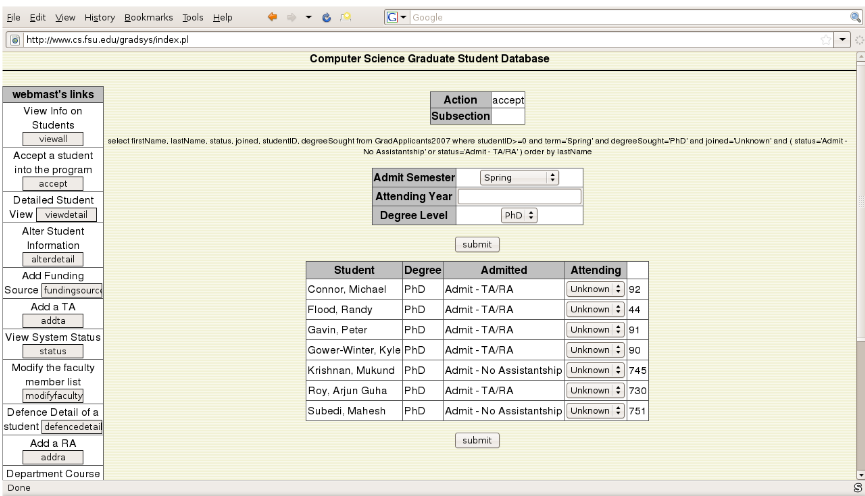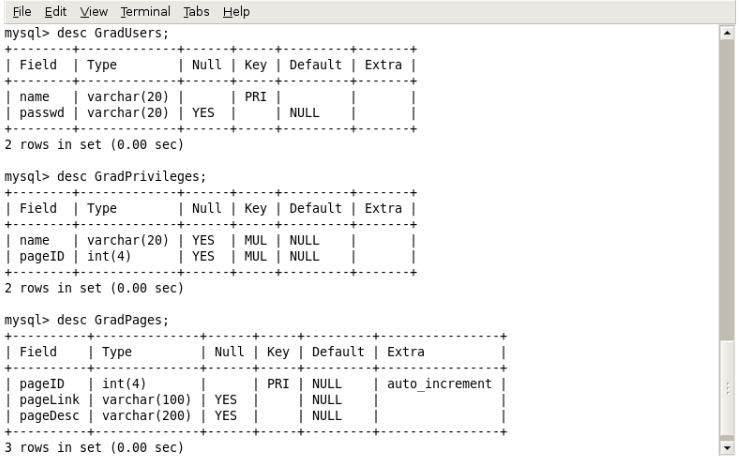INTRODUCTION
In the Computer Science Department at Florida State University, tracking a student’s progress through the graduate program has been handled separately and disjointly by the different staff members based on what they oversee. However, as multiple aspects of the students data must be shared for various tasks, this data is often shared via email and stored redundantly in excel spreadsheets across the department.
This manner of storage often leads to hardships with regards to how the data was managed, updated, and shared; when data needs to be updated, all copies must be updated manually with great care so that out of date information is not kept and recirculated through the system. In addition, various governmental and provisional bodies request periodic surveys to be done on the makeup of the student body. Currently, this is done by sifting through hundreds of papers for all the students and counting them manually. With a centralized system, it could potentially take a single query to count the students on a moments notice.
FUNCTIONAL DESCRIPTION
There are multiple users for this system defined by their role. First is the Director of Graduate Studies. It is this person’s job to initiate the student into the system by using the accept function. Using this functionality, when a student arrives at the university, the director accesses the list of accepted students and creates an entry for the new student into the graduate student database. This is done by changing the status under “attending” to either “yes” or “no” and hitting the submit button. The list of students can be filtered by year, semester, and whether the sought degree is MS or PhD.
The person in charge of payroll also has access to the system to view the costs associated with employing the TAs and RAs. The payroll manager has read access to the TA/RA matrix that the RA and TA managers use to input the financial information. The names of the students were omitted from this viewing of the matrix.
IMPLEMENTATION
Three other tables are used by the database to manage users and their privileges. GradUsers, GradPages, and GradPrivileges (see Fig 8). GradUsers contains the username and the password for the account. GradPages contains pageID, used to uniquely identify the page, pageLink, a link that the script uses to find the correct section of code for that page, and ‘pageDesc’ which is a description for the end users to know what that page is for. GradPrivileges describes user privleges by mapping a user’s username to the pageID’s of the pages he has access to.
FUTURE WORK
While this project has supplied the basics for a system to keep track of students, many further enhancements are desired for greater control of the information.
The first major enhancement would be for advisors to be able to log in and see the information for their students. They should be able to see what prerequisites the students have taken, and still need to take, as well as information about their job, pay, room assignment, and email address. The advisors should also be able to fill out semester and yearly progress reports on phd students who have advanced to candidacy. Also useful would be the ability to record which classes have been recommended by the student’s advisor, as well as taken classes and grades made in said classes.
CONCLUSIONS
In conclusion, a database is a far more efficient mechanism to store and organize data than spreadsheets; it allows for a centralized facility that can easily be modified and quickly shared among multiple users. Having a web based front end removes the requirement of users having to understand and use a database directly, and allows users to connect from anywhere with an internet connection and a basic web browser. It also allows the possibility of queries to obtain information for various surveys. Due to the number of users reading and modifying student data in the department, it is an ideal use for such a system.
Source: Florida State University
Author: Nicholas Wallen
>> List of Final Year B.E/B.TECH Student DBMS Projects using Excel


